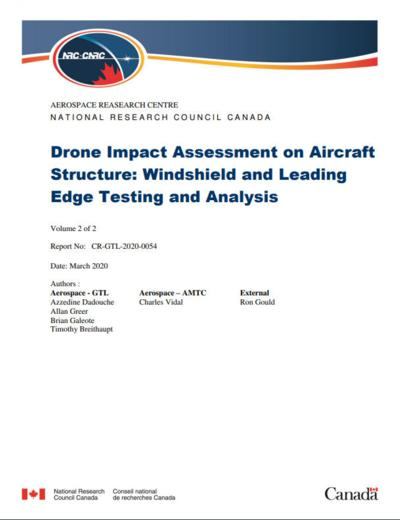Mon, Oct 05, 2020
Simulated Impacts Between A Representative Quadcopter Drone And Various Aircraft Components
Canada's NRC has been busy looking into the potential hazards created when a drone collides with an aircraft... a recently published report further documents the issue.

The report notes that, "Over the last decade, aerial drones have been increasingly used by both professional and inexperienced users resulting in an increased risk of impact incidents throughout the world. Transport Canada has already implemented regulations dealing with the operation of drones, especially in sensitive areas such as airports where a safe distance must be observed. However, the risk of impacting an aircraft at low altitude remains high from both malicious and careless operators."
The NRC Aerospace Research Centre has been performing bird impact testing both on aircraft structures, windshields as well as on engines since the 1960s where a number of pneumatic guns with various sizes have been developed and run for various clients. Over that period, NRC’s bird guns were used to fire real birds, gelatin synthetic birds as well as steel balls. The latter test aimed at certifying a bullet-proof windshield of a fighter aircraft with a firing ball velocity reaching 1.036 Mach, 668 knots.
They say that the main objective of this collaborative work between Transport Canada, Defence Research and Development Canada and the National Research Council Canada is to perform a series of experiments simulating impacts between a representative quadcopter drone and various aircraft components (windshield and wing sections) at typical operating conditions of both the aircraft and drone (impact velocity, mass and type of projectile). The wings and windshields from a typical AWM 525 (Part 25) commercial aircraft were used for these impact tests. Tests were performed at operating conditions typical for approach and cruising speeds of an aircraft under 10,000 feet.
The report gives an overall description of the test setup for windshield and wing leading edge impact testing and provides experimental data along with analysis and discussion.
It makes for fascinating reading.
More News
Also: Netherlands Donates 18 F16s, 2 737s Collide On Ramp, E-7 Wedgetail Cut, AgEagle's 100th In S Korea The Pilot and Aircraft Privacy Act was introduced in the House by Represent>[...]
Pilot Also Reported That Due To A Fuel Leak, The Auxiliary Fuel Tanks Were Not Used On June 4, 2025, at 13:41 eastern daylight time, a Piper PA-23, N2109P, was substantially damage>[...]
Have A Story That NEEDS To Be Featured On Aero-News? Here’s How To Submit A Story To Our Team Some of the greatest new stories ANN has ever covered have been submitted by our>[...]
From 2023 (YouTube Edition): Reflections on War’s Collective Lessons and Cyclical Nature The exigencies of war ought be colorblind. Inane social-constructs the likes of racis>[...]
What Goes Around, May Yet Come Back Around, Klyde FMI: www.klydemorris.com>[...]
 Airborne 06.30.25: US v ADS-B Misuse, Natl STOL Fire, Volocopter Resumes
Airborne 06.30.25: US v ADS-B Misuse, Natl STOL Fire, Volocopter Resumes NTSB Prelim: Piper PA-23
NTSB Prelim: Piper PA-23 ANN FAQ: Submit a News Story!
ANN FAQ: Submit a News Story! Classic Aero-TV: One Mans Vietnam
Classic Aero-TV: One Mans Vietnam Klyde Morris (06.30.25)
Klyde Morris (06.30.25)



